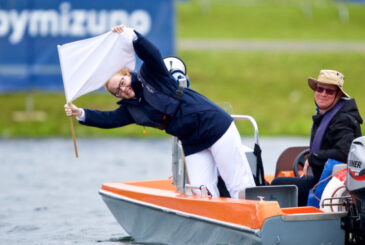We continue this series of articles on the application of the Rules of Racing and their significance to the rowing community by looking at the foul rule
When asked, as an umpire, what is the definition of a foul, many of us will repeat, with a wry smile, rule 7-5-6 of the British Rowing Rules of Racing word for word: “A foul is defined as any collision or contact between boats, oars, sculls or persons in the same race.”
Now, why the wry smile? Well, put simply, there are just some rules worth knowing off by heart.
You would hope that when a firefighter turns up to a raging blaze that they wouldn’t then look baffled at the complex array of pumps and levers and start scratching their head, but they may, understandably, have to recheck the manual when installing a smoke alarm.
Umpiring works in a rather similar fashion, without likening it to the real peril of out-of-control burning – although novice inexperienced pairs can feel rather similar at times.
Lane one decides to join lane three, for – by the look on their face – an unexpected change of scenery
The quicker an umpire intervenes in a certain situation, or is at least armed with the knowledge of what to do next, the more effectively they can – as mentioned in previous articles – restore safety and fairness. But, having to check the rule book for what weight a lightweight is, when you’re blearily staring at the first numbers to appear on the weighing scales two hours before the first race, and four hours before anyone should legally allowed to be awake, is okay too.
Following repeated interference or a foul, the race umpire may:
- Allow the race to continue (e.g. if the offence, in the opinion of the umpire, will not affect the outcome of the race)
- Disqualify any offending crews, and allow the race to continue if more than one crew remains in the race
- Stop the race, disqualify any offending crews and return the remaining crews to the start, to re-row the race (immediately, or at a time to be determined by the programme controller)
- Determine the finishing order
- Adopt a combination of these actions.
So, to set the scene I have a race between four WJ13 single scullers over 1,000m all from the same club and in lanes one to five. Off the start, all is well – albeit slightly wobbly in a prevailing head wind – however, 20m in is where things start to deteriorate.
Lane one decides to join lane three, for – by the look on their face – an unexpected change of scenery. At this point I know I should allow the race to continue as no advantage or disadvantage is being given or received.
Now, imagine that the wrong person had won or that this was an eights’ race for the championship event at a gold-ribbon regatta
For the next 150m all is well in the now three lanes of rowers. The next twist is when lane four joins the party in lane three and fouls lane one with a small clash of blades. As the rightful owner of lane three had made some decent headway into the lead, I can decide to allow them to perform a dynamic detangling and carry on.
So, for the remainder of this race there are similar actions, punctuated with the raising and waving of flags to try and keep it safe and fair.
At the end of the race, I conclude that the right person has won, despite all the carnage and multiple fouls and interference, and that the right people have lost, regardless of what happened in between. Assuming there is no protest by anyone else in the race, all are free to chalk another good day on the water. The coach will no doubt decide to focus on straight-line rowing in the next session.
Now, imagine that the wrong person had won, or that these hadn’t been less experienced crews; or in fact that this was an eights’ race for the championship event at a gold-ribbon regatta.
As umpire, you have no more options at your disposal and you probably have to make a decision that will be difficult to correct if you are wrong – and this will also most likely make you extremely unpopular with crew and coaches who will be demanding that you resign, whether your call is correct or not.
So, herein lies one of the keys to good umpiring; understanding what you should know and what you should never forget. The foul rule – and what to do following a clash of boats, oars, sculls or persons in the same race – is one of those things that is imparted into your umpiring brain from day one.
Next Secret Umpire article: Control commission >>
Find out more about umpiring
Have you considered umpiring?
We are always looking for new recruits to replace those who step down. You can still umpire and race/coach at the same time, as many of our community still do. The minimum requirement is just three separate days and 12 hours per year.
If you are interested, then please contact the National Umpiring Committee. We will then direct you to your regional umpiring committee for training.
You will be warmly welcomed!










